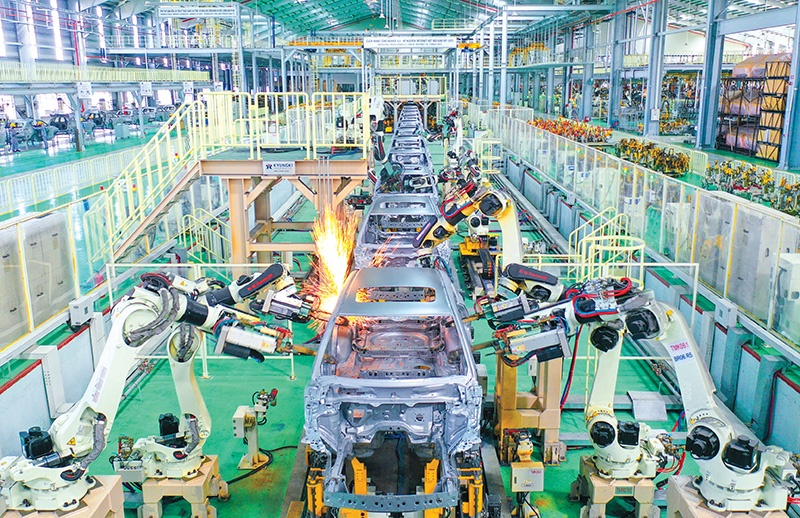Quality the key in digital growth goal
 |
| In the digital era, jobs are expected to be partially replaced with automation, or altered into new ones, photo Le Toan |
Growing up in the northern province of Thai Nguyen, Duong Van Hung was recruited by Samsung Thai Nguyen after his university graduation in 2014.
Nearly one year ago, Hung made a breakthrough in removing the errors that cause dirt and scratches in the process of creating colour and strength for the surface of the phone frame at the company. Thanks to this improvement, the time for installing the product has been reduced 14 times as compared to previously, and the company has been able to save about $1.5 million each year. According to Samsung, this initiative can be applied to all product lines globally.
“Hung’s initiative is excellent, and typical of many others made by Vietnamese people, reflecting the country becoming a more attractive investment destination and improving its labour productivity, meaning higher quality for the economy,” said Prime Minister Pham Minh Chinh, who spoke at a ceremony in Hanoi to honour seven groups and 128 individuals, including Hung, who have created outstanding initiatives in their units’ production and business.
The PM told the National Assembly (NA) that during his meetings with foreign groups, they told him two reasons behind their increased investment in Vietnam.
“First is political stability, which can help investors feel secure in their long-term investments in Vietnam. For example, Standard Chartered is committed to investing $8 billion in sustainable development and green growth in Vietnam over the next five years,” PM Chinh said. “Second is Vietnamese people who are innovative and hard-working. Many of them are tech-savvy, making it favourable for investors to apply high technology and for Vietnam to become a digitalised economy.”
He believed that these two factors will soon help Vietnam attract more foreign direct investment (FDI) in the near future.
The Ministry of Planning and Investment (MPI) reported that in 2021, the total new, adjusted capital and share purchases by foreign investors during January-December 20 hit $31.15 billion, up 9.2 per cent on-year.
In his call for more FDI from the international community, PM Chinh underscored Vietnam’s great efforts to improve the quality of human resources (HR) – one of the key factors receiving great attention from investors.
“To promote the potential of the Vietnamese people, who constitute Vietnam’s most important resource and serve both as the subject and highest goal of development, we have been stepping up capacity building, with a focus on the development of digital HR and a skilled workforce to make the most of the shift in supply chains,” PM Chinh stated at a strategic dialogue between Vietnam and the World Economic Forum held online last October. “We are also stepping up technological development, innovation, and digital transformation.”
| Shimizu Akira - Chief representative Japan International Cooperation Agency
The pandemic has posed great challenges to HR development in Vietnam. Many experts believe that COVID-19 has revealed and even increased the gap in skills required to implement the flexible business strategies of enterprises. Therefore, improving the quality of HR is an urgent issue requiring efforts and cooperation of governments, enterprises, and individuals. In this context, all people and enterprises are forced to face challenges and to make drastic choices to adjust and survive in this unprecedented time of volatility, uncertainty, complexity, and ambiguity. Clearly, people with fewer skills and enterprises with less innovation and flexibility have been more severely impacted. Therefore, vocational schools and higher education could give the younger generation opportunities to equip themselves with the entrepreneurial spirit and necessary business skills. As for enterprises, there has been an increasing tendency in supply chain diversification due to the trade conflict in the global economy. However, operational restrictions have revealed supply chain fragility. The factors for retaining business and attracting investment are becoming more complex. We believe HR development is more important than ever for Vietnam to meet new demands and to remain resilient in the new normal. |
Upgraded quality
According to MPI Minister Nguyen Chi Dung, if labour productivity (LP) is further improved, it can help Vietnam’s innovative economy to grow at an impressive rate of 29-30 per cent a year.
Under the country’s 2021-2025 Economic Restructuring Plan adopted by the NA, Vietnam is expected to annually grow 6.5-7 per cent, with Vietnam set to become a higher middle-income nation by 2025.
The General Statistics Office reported that though the economy grew only 2.58 per cent in 2021, the lowest level since the 1990s, its quality has gradually improved. Based on the constant price in 2021, its LP is estimated to be $7,398 per labourer, up by $538 as compared to that in 2020.
Meanwhile, under the comparative price, the rate in 2021 increased 4.71 per cent thanks to an improvement in labourers’ expertise – the rate of trained labourers with certificates and diplomas in 2021 reached 26.1 per cent, higher than the 25.3 per cent in 2020.
In the 2016-2020 period, total factor productivity (TFP) in GDP hit an estimated 45.42 per cent, up from 33.6 per cent in the 2011-2015 period and far exceeding the initial target of 30-35 per cent. LP during 2016-2020 increased 5.8 per cent annually, up from an average 4.3 per cent a year in the 2011-2015 period.
Moreover, the economy’s incremental capital output ratio, which is the additional capital required to increase one unit of output, has also clearly improved. The ratio was 6.25 in 2011-2015 to 6.14 in the 2016-2019 period. In 2020, the rate rose to 14.28, leading to an average of 7.04 in the 2016-2020 period.
Regarding economic structure, in 2021, the agro-forestry-fishery sector accounted for 12.36 per cent of GDP and the rates were 37.86 and 40.95 per cent, respectively, for the industrial and construction sector and the service sector. The product tax excluding product subsidy held 8.83 per cent.
More improvements needed
For Vietnam to achieve higher growth it is critical that LP, which remains far lower than that of regional nations, is upgraded.
Vietnam has been gradually narrowing the chasm in LP with regional nations which have a higher development level. In 2011, the rate in Singapore, Malaysia, Thailand, and Indonesia was 17.6, 6.3, 2.9, and 2.4 times, respectively, higher than Vietnam’s. However, the difference decreased to 13.7, 5.3, 2.7, and 2.2 times, respectively, in 2018.
The United Nations Development Programme (UNDP) said Vietnam must better prepare for, and adapt to, the impact of Industry 4.0 on drivers of growth and job creation.
“Accelerating Industry 4.0 offers both opportunities and risks in terms of future employment creation, as Vietnam embarks on new growth pathways. It is anticipated that automation and AI will displace jobs in several sectors that have been driving Vietnam’s growth,” said a UNDP report on Industry 4.0 impacting Vietnam.
Under Vietnam’s 2021-2025 Economic Restructuring Plan, the first solution to achieve higher economic growth with better quality is to increase LP.
PM Chinh said that in order for Vietnam to have many excellent labourers like Duong Van Hung from Samsung Thai Nguyen, the country needs to have more favourable policies in education and training, and create better working conditions.
“The government will enact special incentives to encourage enterprises to invest into research and development and innovation, and engage in global value chains” stated PM Chinh.
The NA is set to revise the Law on Employment in a manner suitable to the digital era in which there will be a plan to reduce informal employment to below 50 per cent by 2025 from 56 per cent last year.
Businesses are being facilitated further to engage in Vietnam’s education and training sector, in which universities and institutes are encouraged to cooperate with enterprises to establish scientific and technological businesses.
What the stars mean:
★ Poor ★ ★ Promising ★★★ Good ★★★★ Very good ★★★★★ Exceptional
Related Contents
Latest News
More News
- Long-term capital seen as key hurdle to green growth (December 16, 2025 | 08:00)
- HDS Summit spotlights Vietnam’s rising role in regional supply chains (December 16, 2025 | 08:00)
- Agribank frames bank credit as catalyst for green growth (December 15, 2025 | 17:59)
- Legal framework completed for national digital transformation (December 13, 2025 | 21:55)
- SOAR initiative launched at TECHFEST Vietnam 2025 (December 13, 2025 | 10:00)
- Promoting digital assets initiative in Vietnam (December 13, 2025 | 09:30)
- Legislation gives government flexibility for loan guarantees (December 11, 2025 | 18:04)
- Vietnam masters core technologies of automobile value chain (December 11, 2025 | 17:46)
- Japanese investors pursue M&A strategies with long-term vision in Vietnam (December 11, 2025 | 12:14)
- Raising product quality to secure Vietnam’s position in US market (December 11, 2025 | 12:00)


 Tag:
Tag:






















 Mobile Version
Mobile Version